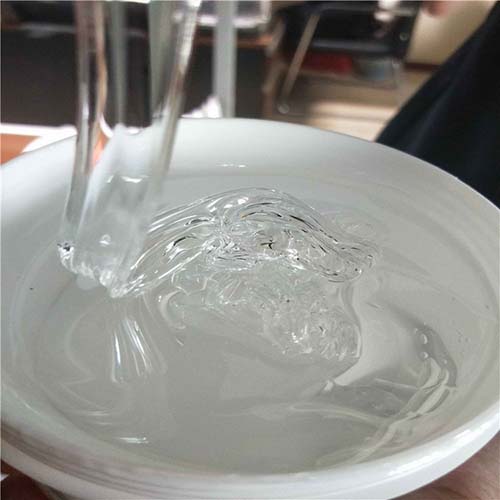Polyisobutylene: Industrial Production and Biomedical Application
General Description
The industrial production of Polyisobutylene involves polymerizing isobutene using various catalysts to control molecular weight, influencing its applications. Low molecular weight variants, produced with BF3/ROH, are essential for lubricants and sealants, while medium weights use AlCl3/ROH or H2O for adhesives and automotive parts. High molecular weight Polyisobutylene is crucial in manufacturing butyl rubber for tires due to its impermeability. In the biomedical field, Polyisobutylene serves as a foundation for advanced elastomers in vascular grafts and drug delivery, notably enhancing bone cement's toughness and biocompatibility. Ongoing research aims to improve its stability and reduce infection risks in medical implants.

Figure 1. Polyisobutylene
Industrial Production
Overview of Production
The industrial production of Polyisobutylene (Polyisobutylene) involves a variety of complex processes centered around the polymerization of isobutene. Various catalysts are utilized to control the molecular weight (MW) of Polyisobutylene, which is crucial for determining its practical applications in industries. For instance, the use of BF3/ROH catalyst systems is prominent in the production of low molecular weight Polyisobutylene, which are in high demand due to their applications in lubricants and sealants. On the other hand, medium molecular weight Polyisobutylene is typically produced using AlCl3/ROH or H2O catalytic systems. These Polyisobutylene products find their use in a range of applications, from adhesives to automotive parts, highlighting their versatility and importance in modern industrial applications. 1
Applications and Market Dynamics
The market dynamics of Polyisobutylene are influenced by the diverse applications of its different molecular weight forms. High molecular weight Polyisobutylene, in particular, has dominated the market in monetary terms due to its critical role in the manufacture of butyl rubber and halogenated butyl rubbers. These materials are integral to the automotive industry, serving as key components in tire manufacturing due to their impermeability and resistance to weathering. Furthermore, the ongoing research and development in catalytic processes aim to enhance the efficiency of Polyisobutylene synthesis, particularly for high-performance applications where advanced properties such as improved stability and durability are required. This continuous innovation ensures that Polyisobutylene remains a vital material in various industrial sectors, driving its production and application across the globe. 1
Biomedical Application
Biomedical Applications in Soft Tissue Replacement
Polyisobutylene has garnered significant attention in the biomedical sector, particularly as a foundation for advanced thermoplastic elastomers. Its inherent properties, such as superior chemical stability and low permeability, make Polyisobutylene an attractive option for applications like vascular grafts and drug delivery systems. Research conducted at the University of Akron has demonstrated that modifying bone cement with Polyisobutylene markedly enhances its fracture toughness, indicating its potential in orthopedic applications. Additionally, the development of amphiphilic hydrogels containing Polyisobutylene mixed with hydrophilic segments has shown promise for coating vascular grafts. These hydrogels exhibit excellent biocompatibility and serve an essential role in controlling the permeability of the grafts, allowing for small nutrient molecules and growth factors to pass while restricting larger immune-affecting entities. Such advancements illustrate how Polyisobutylene can contribute to restoring normoglycemia in diabetic models, showcasing its applicability in chronic disease management. 2
Enhancing Medical Implants with Polyisobutylene-Based Materials
The structural versatility of Polyisobutylene enables the creation of block copolymers that combine desirable properties for medical implants. First-generation Polyisobutylene-polystyrene block copolymers have been shown to exhibit remarkable biocompatibility and resistance to infection, making them ideal candidates for long-term use in vascular or endoluminal devices. These biomaterials maintain structural integrity even under severe conditions, such as concentrated nitric acid exposure, which typically compromises other polymers. The unique composition of Polyisobutylene contributes to its stability, potentially leading to lower instances of inflammation and encrustation, which are critical for maintaining functionality in urinary tract implants. Current studies are exploring the incorporation of antimicrobial agents into Polyisobutylene polymers to further reduce infection risks associated with implanted devices. As research continues to innovate around Polyisobutylene's capabilities, the path forward includes tackling significant challenges like encrustation and biocompatibility to optimize the efficacy of medical implants for real-world applications. 2
References:
[1] ILYA E NIFANT’EV. Polyisobutylenes with Controlled Molecular Weight and Chain-End Structure: Synthesis and Actual Applications.[J]. Polymers, 2023, 15 16. DOI:10.3390/polym15163415.[2] JUDIT E. PUSKAS Y C. Biomedical Application of Commercial Polymers and Novel Polyisobutylene-Based Thermoplastic Elastomers for Soft Tissue Replacement?[J]. Biomacromolecules, 2004, 5 4: 1141-1624. DOI:10.1021/bm034513k.
You may like
Related articles And Qustion
See also
Lastest Price from Polyisobutylene manufacturers

US $100.00/kg2025-11-17
- CAS:
- 9003-27-4
- Min. Order:
- 1kg
- Purity:
- 99%
- Supply Ability:
- 20tons

US $1.00/KG2025-06-10
- CAS:
- 9003-27-4
- Min. Order:
- 1KG
- Purity:
- 99%
- Supply Ability:
- 10 ton




